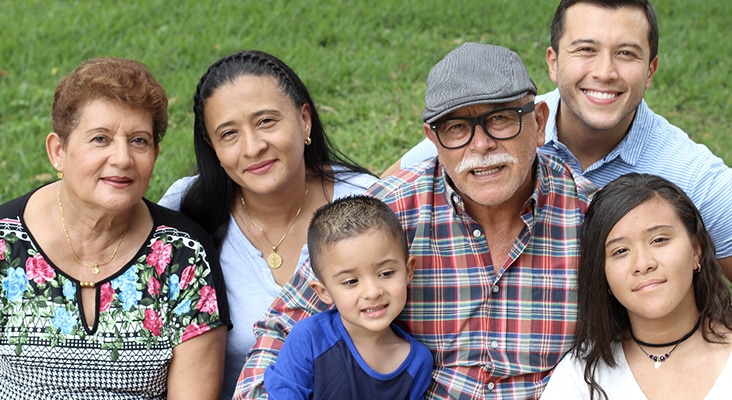Addressing a Caries Epidemic
Dental caries affects a large proportion of American Indian and Alaska Native (AI/AN) children before they begin school, and at levels of severity that surpass other population groups.

Caries Epidemic Among Native American Populations
Dental caries affects a large proportion of American Indian and Alaska Native (AI/AN) children before they begin school, and at levels of severity that surpass other population groups. As reported in the Indian Health Service’s 2010 Survey of Preschool Children, 62.3% of AI/AN children age 2 to 5 had decay experience with a mean of 4.2 teeth affected per child. In comparison, a recent National Health and Nutrition Examination Survey (NHANES) reported that 22.7% of general-population children age 2 to 5 had caries experience, with a mean of 1.2 teeth affected.
Photo Credit: FatCamera / E+

Socioeconomic Status
Dental caries is a disease closely related to poverty, with data from NHANES showing that children living at or below the United States federal poverty level have substantially higher rates of caries than those not living in poverty. Poverty also appears to be a contributing factor to caries in the AI/AN population, as many reservations—particularly those in the plains and the West—are situated in some of the most impoverished counties in the US. There is considerable variation in the prevalence and severity of caries within the American Indian population, with higher prevalence reported among those groups living in the poorest counties. Associations between poverty and high caries prevalence and severity are not fully understood at this time, but it seems that poor diet, lack of self-care, and limited access to dental preventive and treatment services likely play roles.
Photo Credit: ajr_images / iStock / Getty Images Plus

Sugar Consumption
A recent longitudinal study found sugar-sweetened beverages were associated with caries among 3-year-old American Indian children, suggesting that sugar-sweetened beverage consumption is also a caries risk factor in this community. Addressing the dietary shortcomings of AI/AN groups is made especially difficult by the geographic isolation of many tribal communities. Reservations are typically served by small grocery stores that, to stay profitable, focus on products with relatively long shelf lives and high profit margins. As a result, processed foods and sugar-sweetened beverages are common, while healthy food choices, such as fresh fruits or vegetables, are limited. The availability of cheap, high-sugar foods combined with high poverty rates can lead to cariogenic diets. Moreover, with limited food choices available (or affordable), efforts to improve dietary practices have little chance for success.
Photo Credit: sam thomas / iStock / Getty Images Plus

Access to Care
A severe dental access problem exists in AI/AN communities. Simply put, there are not enough dental providers to meet the needs of these communities. While many dental clinics, whether operated by the Indian Health Service (IHS) or tribal communities, are modern, up-to-date facilities, the remoteness of many AI/AN communities makes it difficult to recruit and retain dentists, dental hygienists, and other oral health professionals. As a result, 15% to 20% of dentist positions remain consistently vacant within the IHS. The dental professionals who are employed by the IHS or tribal communities are sometimes overwhelmed by emergency needs, leaving insufficient time to provide routine care or to focus on preventive tactics. Moreover, there is a shortage of pediatric dentists in tribal communities. As such, appropriate care may only be available off-site (eg, hospital settings) for the many children who have extensive oral health care needs. In addition to these challenges, adequate housing is often difficult to find in or near tribal communities, and there may be limited employment opportunities for dental professionals’ family members.
Photo Credit: grandriver / E+

Prevention Efforts
Preventive and mitigative efforts must begin early in these childrens’ lives and should likely include oral health education and behavioral modifications by expectant mothers. Oral health education and behavioral modifications aimed at new and expectant mothers seems a necessary feature of any solution to this problem, especially in light of the early onset of caries in AI/AN children. Such efforts should be based on theoretical frameworks that use proven tools, including motivational interviewing and interventions based on the self-determination theory—both of which have been shown to improve parental oral health behaviors.
Photo Credit: FatCamera / E+

Health Management Approach
Another potential solution is to use a health management approach to provide early screening and referral for caries prevention and treatment. Under this approach, dental hygienists, nurses, or other licensed clinicians perform oral health screenings to determine how urgently an individual needs professional oral health care services. If treatment is needed, dental care options are provided based on location, availability of appointments, and type of care required. The care coordinator assists in arranging transportation to dental facilities, finding child care, and communicating appointment reminders to patients to help ensure that scheduled dental visits occur. The care coordinator might also provide direct preventive care, including fluoride varnish application and application of dental sealants, in a variety of dental and nondental settings.
Photo Credit: LindaYolanda / E+

Role of Fluoride
Traditional dental preventive strategies—including the use of fluoride toothpaste, frequent application of fluoride varnish, and use of new anti-caries products, such as silver diamine fluoride (SDF)—should be considered. It has been suggested that fluoride toothpaste is used less frequently than recommended in AI/AN populations, which may be related to the high rates of poverty in these communities. As such, one possible solution would be to provide fluoride toothpaste and instructions for use to parents/caregivers of young AI/AN children. Similarly, although biannual application of fluoride varnish has been shown to be effective in some populations, evidence is lacking as to whether monthly or quarterly applications would offer increased levels of prevention in disease-prone AI/AN communities. SDF may aid in the primary and secondary prevention of dental caries in young children.

